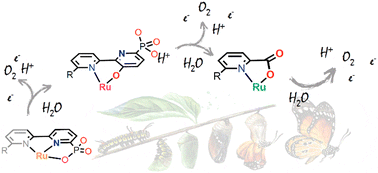Metamorphic Oxygen-evolving Molecular Ru and Ir Catalysts
Today sustainable and clean energy conversion strategies are based on sunlight and the use of water as a source of protons and electrons, in a similar manner as it happens in Photosystem II. To achieve this, the charge separation state induced by light has to be capable of oxidising water by 4 protons and 4 electrons and generating molecular oxygen. This oxidation occurs by the intermediacy of a catalyst capable of finding low-energy pathways via proton-coupled electron transfer steps. The high energy involved in the thermodynamics of water oxidation reaction, coupled with its mechanistic complexity, is responsible for the difficulty of discovering efficient and oxidatively robust molecules capable of achieving such a challenging task. A significant number of Ru coordination complexes have been identified as water oxidation catalysts (WOCs) and are among the best understood from a mechanistic perspective. In this review, we describe the catalytic performance of these complexes and focus our attention on the factors that influence their performance during catalysis, especially in cases where a detailed mechanistic investigation has been carried out. The collective information extracted from all the catalysts studied allows one to identify the key features that govern the complex chemistry associated with the catalytic water oxidation reaction. This includes the stability of trans-O–Ru–O groups, the change in coordination number from CN6 to CN7 at Ru high oxidation states, the ligand flexibility, the capacity to undergo intramolecular proton transfer, the bond strain, the axial ligand substitution, and supramolecular effects. Overall, combining all this information generates a coherent view of this complex chemistry.

Vereshchuk, N.; Gil-Sepulcre, M.; Ghaderian, A.; Holub, J.; Gimbert-Suriñach, C.; Llobet, A.
Chem. Soc. Rev. 2023, (52), 196-211
DOI:
10.1039/d2cs00463a

Let's create a brighter future
Join our team to work with renowned researchers, tackle groundbreaking
projects and contribute to meaningful scientific advancements




















